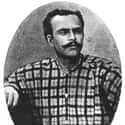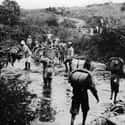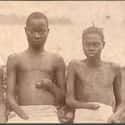-
(#3) The Anglo-Belgian Rubber Company Earned Huge Profits By Exploiting, Torturing, And Maiming Its Slave Laborers
The Anglo-Belgian Rubber Company, later known as the Compagnie du Congo Belge, was the company in charge of fulfilling Leopold II's demand for rubber, even though he never actually set foot in the Congo. The company boomed in the late 1890s at an exorbitant cost to human rights. With the extensive exploitation of the native Congolese came high profits for the Belgians, and the company, later known as the Abir Congo Company, flourished for decades until its downfall in 1905. A commission of inquiry was sent to the Congo Free State and discovered the inhumane treatment of the Congolese people. That, and falling profits, led to the end of the Abir Congo Company, but the damage had already been done.
-
(#2) The Photographer, Alice Seeley Harris, Wrote a Book About What She Saw In The Congo
Alice Seeley Harris, pictured here with her husband, was stationed as a missionary in the Congo in 1898. During her years in the Congo, Harris taught English to the locals and photographed what she saw as she became increasingly horrified and disgusted at what she saw happening there. In 1904, she took the now-famous photograph of Nsala staring at his daughter's severed extremities.
In one of her many books, Don't Call Me Lady: The Journey of Lady Alice Seeley Harris, Harris's description of Nsala took a turn and became a scathing rebuke of Leopold II. She wrote: "All of this filth had occurred because one man, one man who lived thousands of miles across the sea, one man who couldn’t get rich enough, had decreed that this land was his and that these people should serve his own greed."
-
(#6) The Actual Process Of Gathering Rubber Was Brutal And Painful, Too
The Congolese suffered immensely under Belgian rule in the late 19th and early 20th centuries. Not only were their hands chopped off for failing to meet their rubber collection quota, but Congolese slaves also endured many other hardships as well. In order to fulfill entirely unrealistic rubber collection quotas, Congolese slaves were forced to venture deep into the forests and often end up covered in the extracted rubber, which would then harden on their skin and have to be painfully scraped off.
-
(#9) An Italian Anarchist Nearly Assassinated Leopold II
Leopold II's regime wasn't entirely popular within Europe, even before the Casement Report revealed the true nature of his doings in the Congo. Many in 20th century Europe were ready to do away with the tethers of old-world monarchy and regulations, and some were willing to go further than others to make a change. On the morning of November 15, 1902, Gennaro Rubino, and Italian anarchist, attempted assassination upon the Belgian king.
Rubino fired three shots while Leopold was riding in his carriage, but each of them missed. Rubino was immediately arrested and sentenced to life in prison. During the inquiry, Rubino told the police that he would have fired "at the King of Italy as readily as at the King of Belgium, because monarchs are tyrants who cause the misery of their peoples." Separate from the horrors of Leopold's regime in the Congo, the world was waking up to the systemic inequality monarchies imposed upon their subjects.
-
(#7) Joseph Conrad's 'Heart Of Darkness' Drew Inspiration From The Real Events In The Congo
One of the most well known literary depictions of the Congo Free State is Joseph Conrad's 1899 novella Heart of Darkness. The story, set in the Congo Free State, is a gruesome tale of men traveling up the Congo river into Africa. The 2016 film The Legend of Tarzan is also set in the Congo Free State, and despite not being a historical film, it does touch on the historical events of Leopold II's reign of terror.
-
(#5) Hands Like The Severed One In The Photograph Were Used As A Morbid Currency In The Congo
The brutality of the Belgian militia stationed in the Congo Free State was systematic, and it was premised on the threat of extreme bodily harm to all those who committed an infraction of any kind. The military force, known as the Force Publique, was a mercenary force comprised of Belgian commanding officers with African soldiers. These mercenaries were required to cut off the hands of those they murdered for not fulfilling the rubber quota. It was believed that if they did not show proof of how the ammunition was used, they must have wasted it on hunting.
A stockpile of hands meant good things for a soldier, and hands became a sort of currency for the Force Publique. This led to mass mutilation of innocent victims who often died as a result. Some slaves managed to play dead by not moving after having their hands chopped off.
New Random Displays Display All By Ranking
About This Tool
I believe that everyone who has seen this photo will never forget it. In the photo, a man named Nsala looked sadly at his 5-year-old daughter whose hands and feet being chopped off. Because he did not reach the harvest target set by the rubber company, the Belgian Rubber Company cruelly dismembered his daughter in order to punish him. Such tragedies were innumerable in Congo in the 1900s.
The local rubber companies forced labor and reduced labor costs, which caused many violent and bloody incidents. The workers were forced to take photos with the severed hands and feet. These tycoons were also known as "robbers and nobles". The random tool introduced 9 brutal facts about the dark period in Congo.
Our data comes from Ranker, If you want to participate in the ranking of items displayed on this page, please click here.
















